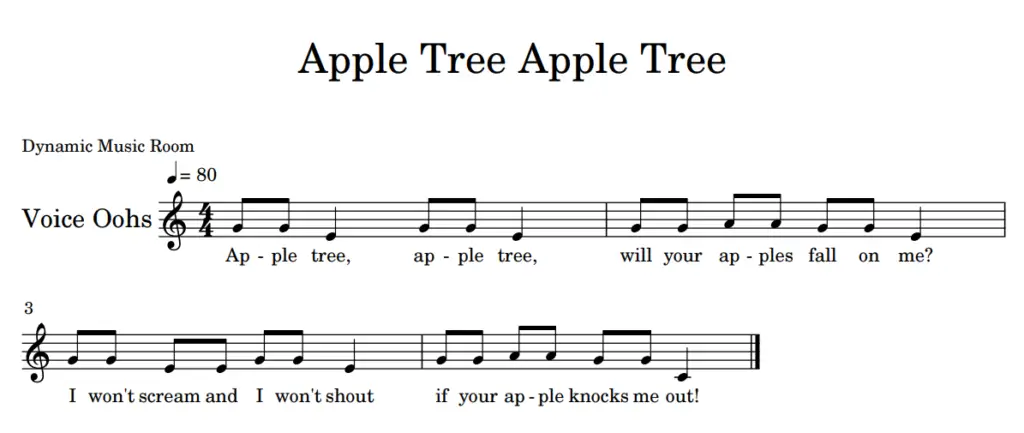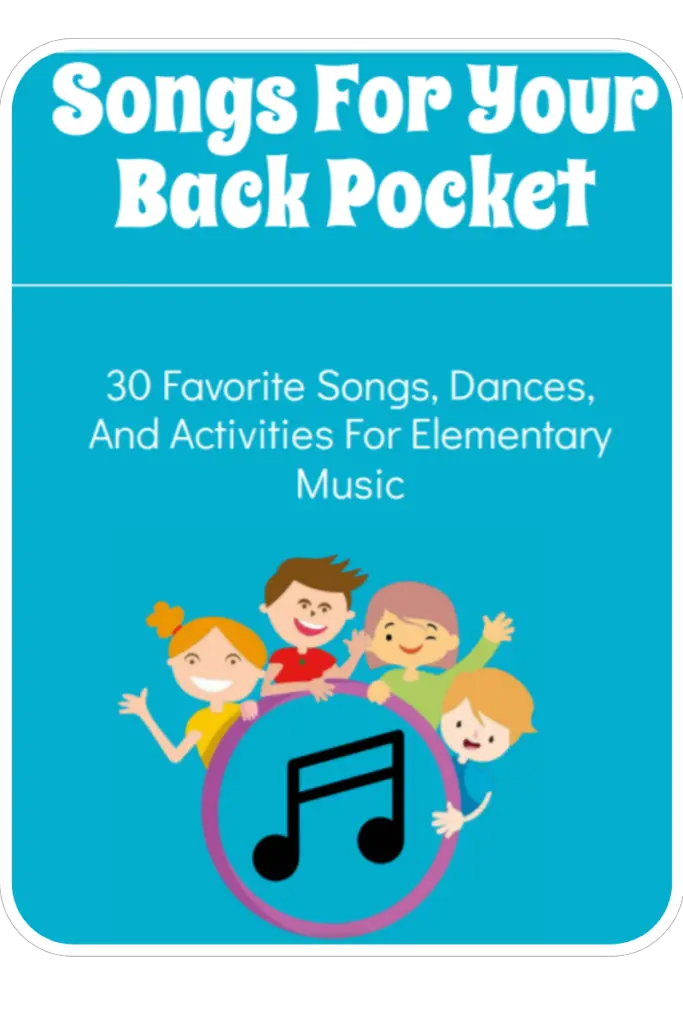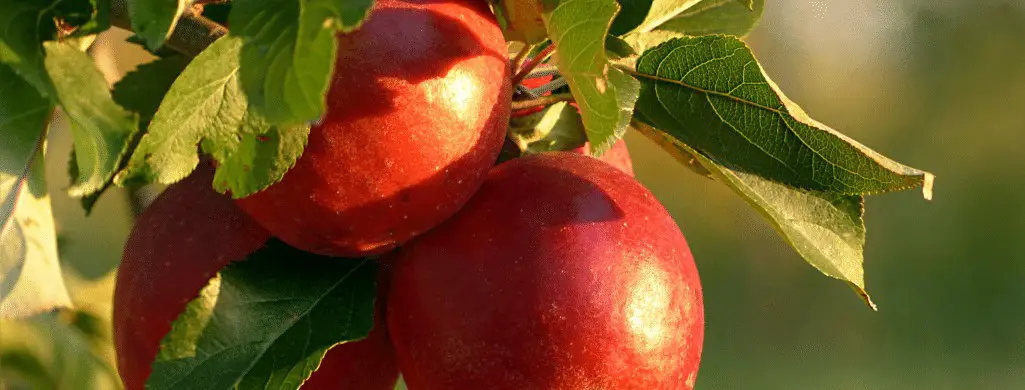Every once in a while, you come across a song that you use in your music class over and over again.
One of these, for myself and many others, is the Apple Tree folk song. This is another traditional Kodaly song, but it works for any method.
In fact, I challenge you to stop thinking of music methods as existing in their own universe. Every method has something for everyone.
But soapbox aside, this folk song is perfect for First and Second graders and comes with some awesome lesson ideas.
Let’s get into it and discuss them together below.

Save time with these 60 FREE Music Resources to use in your room right away!
Stop searching the whole internet to find good activities. I’ll help you cut to the chase with my favorite 60 FREE resources.
Table of Contents
Apple Tree Kodaly Song And Sheet Music

Lyrics:
Apple tree, apple tree
Will your apples fall on me?
I won’t scream, and I won’t shout
If your apple knocks me out!
As we can see from the sheet music above, this is the perfect song to use in your first-grade and second-grade music rooms.
For melodic or pitch concepts, we get an awesome Sol, Mi, La, and Do.
In first grade, I’d isolate the sol-mi-la patterns and leave the Do as it is.
But then, bring it back in second grade when you teach Do, and you don’t have to teach a brand new song for it.
For rhythm concepts, it’s all about the quarter notes versus paired eighth notes.
There’s not much variety here, but if you bring this song back in second grade, it can serve as a great reminder of what they learned in first grade in terms of rhythm value.
Apple Tree Circle Game
I’ve seen a few variations of the circle game that goes with this folk song, but here’s my favorite:
- Two students stand, taking hands with their arms up (think London Bridge). They are the tree!
- Everyone else stands in a circle taking hands (think Ring Around The Rosie). The big circle (at least at first) needs to go through the tree.
- Sing the song and the big circle (not the tree) rotates through the tree’s arms while holding hands.
- At the end of the song (“knocks me out”), the tree students drop their arms to “catch” some other students.
- Any student caught (it can be more than one) leaves the big circle and becomes part of the tree. The tree gets bigger.
- Reset in tree form, and student circle and play again.
- Continue playing and capturing students until everyone has had a turn or you’re out of time.

Tired of searching and searching for songs that work?
I’m saving you headaches and wasted time spent looking for good activities with this eBook of my 30 favorite songs, dances, and activities for elementary music. Get back to making music right now!
4 Quick Apple Tree Folk Song Lesson Ideas
Check out these fast ways to add intentional musical learning into your lessons using the Kodaly song, Apple Tree.
Word-Rhythm Replacement
Practice reading the rhythm with the students using your preferred rhythm syllables.
If we’re sticking with the traditional rhythm syllables, this would be something like Ta for quarter notes and Titi for eighth notes.
Gordon/Froseth would use Du and Du-de.
Takadimi would use Ta and Ta-di.
After reading the rhythms, challenge students to replace the rhythm syllables with the word “Tree” for quarter notes and “Apple” for eighth notes.
So now our phrase goes from:
Titi Ta Titi Ta Titi Titi Titi Ta
To:
Apple Tree Apple Tree Apple Apple Apple Tree
After they’ve got this, challenge the students further to come up with new plant-related words to swap out for rhythms.
Single-syllable words for quarter notes may include:
- Tree
- Plum
- Leaf
- Root
Two-syllables words for eighth notes may include:
- Branches
- Walnut
- Cherry
- Maple
There are a ton of options out there.
Harness your students’ creativity by allowing them options.
Apple Tone Ladder
A tone ladder is where pitches are arranged vertically like a ladder.
Many music teachers will make a class set of tone ladders as needed for different concepts, either using a piece of laminated paper the size of a bookmark OR a wide popsicle stick.
Either way, put apples on the tone ladder and label them with Sol, Mi, and La (Do if 2nd grade or if you want to).
Now, as you sing the song using words or syllables, have the students touch the notes.
This gives them a physical way to see and feel the distance between the solfege pitches.
Bring tone ladders out often enough, and the students will be able to use them for other songs and even as a tool to improvise.
Rhythm-Solfege-Lyric Switcheroo
For this game, students need to be very confident with performing the song with words, rhythm syllables, and solfa syllables.
Prepare students like this:
Alright, folks. We’re going to sing Apple Tree but look at this.
Show them a triangle or drum or another auditory cue.
When you hear this sound, you need to switch from singing the words to singing the rhythm syllables. When you hear it again, you switch to singing with solfege.
Then, if you hear it again you switch back to the regular words.
I’ll try to trick you, so I hope you’re paying attention.
Do the song several times in this way and make it a fun challenging game for the kids.
They won’t even know how much concentration and skill this takes, they’ll have so much fun!
Music Staff Hopping
After students are somewhat familiar with how to read solfege on the staff, find a way to put some lines on the ground either by using carpet tape or getting a carpet with the music staff on it.
Demonstrate this first, but basically what you’re going to do is hop your way through the staff and sing the song with a few students at a time.
It’s sort of like musical hopscotch!
This is a fun and very kinesthetic way of reinforcing pitch and melody understanding.

Save time with these 60 FREE Music Resources to use in your room right away!
Stop searching the whole internet to find good activities. I’ll help you cut to the chase with my favorite 60 FREE resources.

